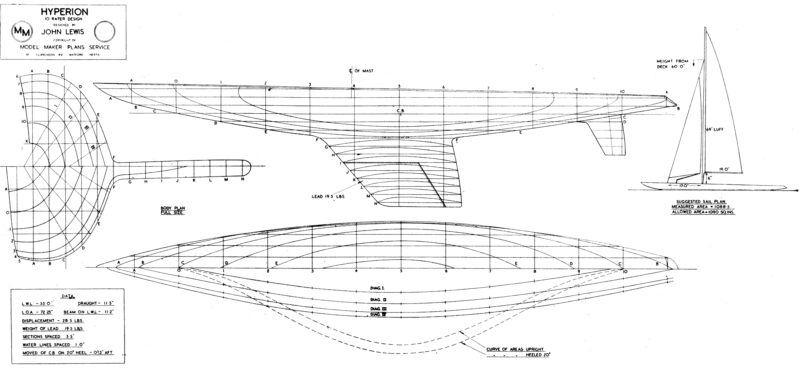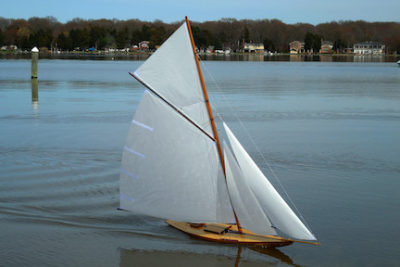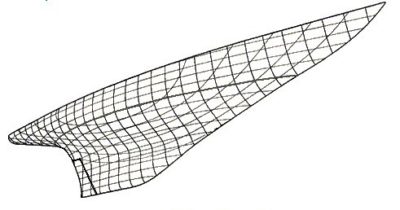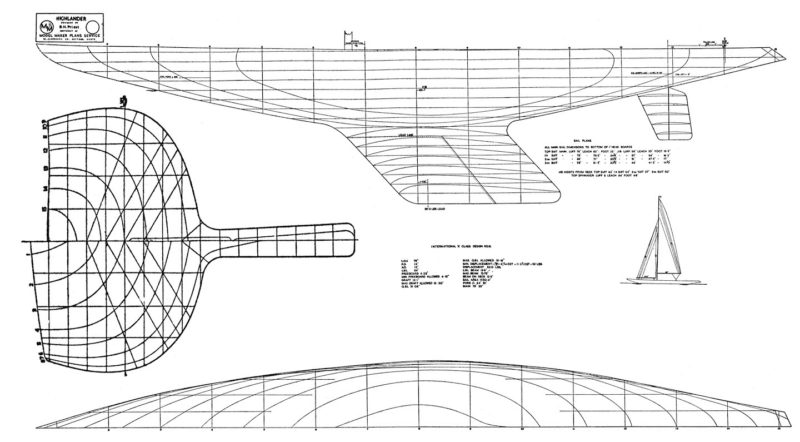Rating Rules for Vintage Models
Author and photos John Henderson
Illustrations US VMYG Archives
This article was conceived when a few of us spent some winter hours looking through plans for vintage models including 10-Raters, A-class boats, and other designs that fall within the US Vintage Model Yacht Group’s purview. These designs were based on rating rules that embodied our hobby’s early attempts to rate disparate models. Not surprisingly, the approaches to rating these early models paralleled those of full-size yachts of the same era. Our casual discussions morphed into an examination of some of the history of our hobby and the evolution of model boat design.
Any essay on this subject will start by saying that the purpose of rating rules is to allow fair competition among boats of different sizes. Any honest writer will acknowledge the many rating rules that have been implemented over many years, especially for full-size boats, each with the same stated goal, and each trying to fix the ways in which its predecessor failed. And we’re not done yet. This succession of rating rules has been accompanied by impassioned arguments among skippers who were certain that their racing results, as established by whatever current rating rule, did not fairly represent their own actual sailing skill. One of the misadventures of my younger years was service on a regional rating committee for full-size boats. I probably haven’t heard all of the arguments, but I’ve got lots of stories of sailing fantasies.
Rating rules attempt to quantify and balance the speed-producing aspects of a design against those that generally slow it down. The big factors are waterline length, sail area (both of which tend to increase speed), and displacement (which tends to diminish speed). The various rules have combined these factors in ways that range from quite simple to quite complicated. For example, “length” is not as straightforward as it seems, because the actual length of the waterline when the boat is heeled might be different from the “designed” waterline, and some rules try to quantify this effect.
Some comments:
- “Rating rules”, for the purposes of this article, do not include rules such as those defining the Marblehead class. Marblehead rules do not supply a “rating”; rather, they simply define the boat—i.e., it must have LOA of 50 in and a sail area of 800 in2, plus some other limits on draft, garboard shape, etc.
- Some of us have raced full-sized boats under the Performance Handicap Rating Formula (PHRF) system. That rating system is not the same as the “rating rules” that we will discuss here. PHRF attempts to assess boat speed potential based on observations of racing results, not on actual measurements of the boats. The “rating rules” that we discuss here are based on measurements.
Early Rules: Length and Sail Area
The 10-Rater Rule
In the 1880s, a very simple length-and-sail area rule was proposed: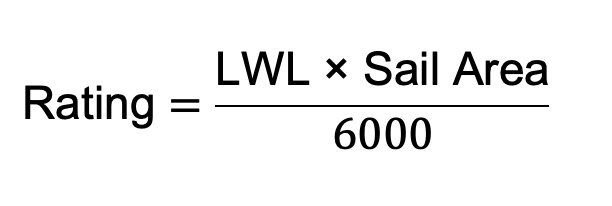 where LWL is the designed (load) waterline in inches and sail area is in square inches.
where LWL is the designed (load) waterline in inches and sail area is in square inches.
This rule (with appropriate measurement units) was adopted for both models and full-size boats. For a 10-Rater model, the equation above calculated to 10 using English units of inches, meaning that the dimensions of a legal 10-Rater model, when entered into this formula must result in a number no greater than 10. Note that this same length-sail area formulation is still used today for modern 10-Rater models, but it is re-stated in metric units. The general formulation anticipates larger (or smaller) models, perhaps 15- or 20-Raters, but I do not know whether they ever evolved.
Note that overall length is not measured, which encourages very long bow and stern overhangs among those who hope to increase the waterline length when the boat heels. Likewise, neither beam nor draft is measured, and I think early designs to this rule tended to be shallow, flat hulls with deep keels. Displacement is not measured either, although there is some indirect control via the length and sail area effects on rating and practical stability.
On its face, a simple rule like this would appear to encourage boats with a very short waterline and a huge sail area, at least for light conditions, but the evolution of the class actually followed “healthier” trends. The class is still active today, especially in the UK. For10-Rater designs of the “vintage” era, there is discussion in E.W. Hobbs’ book Model Sailing Boats. He even includes a table (for the arithmetically challenged?) showing the trade-off between length and sail area, ranging from an LWL of 30 in with associated sail area of 2000 in2 up to an LWL of 60 in and sail area of 1000 in2.
An example of a boat designed to the 10-Rater rule is given in Fig. 1.
The Seawanhaka Rule
There were other versions of length-and-sail area rules, especially for full-size boats. An example of note was developed at the Seawanhaka Yacht Club, with the formula: By taking the square root of the sail area and summing (rather than multiplying) in the numerator, this rule (unlike the 10-Rater rule) is expressed in units of length. This rule was used for the America’s Cup from 1893 until 1903—a time period that includes Columbia, the author’s model, shown in Photo 1.
By taking the square root of the sail area and summing (rather than multiplying) in the numerator, this rule (unlike the 10-Rater rule) is expressed in units of length. This rule was used for the America’s Cup from 1893 until 1903—a time period that includes Columbia, the author’s model, shown in Photo 1.
Comparing the 10-Rater and Seawanhaka formulas shows that the 10-Rater rule treats length more gently than Seawanhaka. Working through some specific examples will show that, for the same length increase, one would have to reduce the sail area more under Seawanhaka in order to preserve the rating. Perhaps this explains why the 10-Rater formula has encouraged long boats and has avoided temptation to make excessively beamy boats. There is more discussion of these points in a book by Dixon Kemp called A Manual of Yacht and Boat Sailing.
International Rules (sometimes called “Meter-Boat Rules”)
In the early years of the 20th century, there was a move to promote more “seaworthy” boats than the designs encouraged by the length-and-sail area rules. Specifically, heavier and somewhat beamier boats with fuller underbodies, “slacker” turns to the bilge, and a much less “fin-like” keel were encouraged. 12-meter yachts (and 6-meter yachts) were built to these rules. (Interestingly, according to Wikipedia, the 5.5-meter class of full-size yachts follows a design rule quite similar to our A-Class model rating rules.)
The lines of an example International Rule boat are shown in Fig. 2, which can be compared with Fig. 1 to reveal the obvious differences in hull shape. The lines in Fig. 2 are actually those of a typical 12-meter yacht.
According to Hobbs’s Model Sailing Boats, the 1908 formulation of the International Rule was: where:
where:
L = waterline length (more or less – there were some modifications from the straightforward dimension)
B = beam
G = chain girth (stretch a chain from gunwale to gunwale around the keel)
d = difference between chain girth and actual (“skin”) girth measured by following the surface of the hull
S = sail area
F = freeboard (as measured in a specified and detailed procedure)
I guess that the girth and freeboard measurements were added to promote what were regarded as “wholesome” designs. In particular, the chain girth measurement was a new addition that penalized (eliminated, as a practical matter) fin keels.
For a 12-meter boat, the formula would have to work out to a number no greater than 12 meters. (Note that 12 meters is not the length of the yacht.) This rule evolved a bit during the heyday of the 12-meters, but the rule structure and basic concepts remained, as did the general boat shape that the rule was meant to encourage. (And here I do not allow myself to be side-tracked into a discussion of the famous winged keel.)
The difficulties of measuring a model’s conformance to this rule are manifest. The AMYA’s two 12-meter classes are essentially one-designs, which circumvents the problem of measuring every model.
“A” Class Rating Rule
For our vintage boats, I will use the formulation of the A-Class rule from 1957, which is expressed in English units of inches and pounds (the modern version of the A-Class rule is metric, but equivalent). Accounts of the history of this class indicate that it was intended to produce models that would act very much like full-size boats and could be used as a guide to design developments. The A-Class models were intended to be 1/6 size (i.e., 2 in = 1 ft) of yachts whose length did not exceed 6 meters (19.68 ft). Some historical accounts (e.g., Hobbs) refer to this as the “18-footer Class”, although the attentive reader will note that 18 feet only equals 6 meters for large values of 18.
The rating formula for the A-Class is: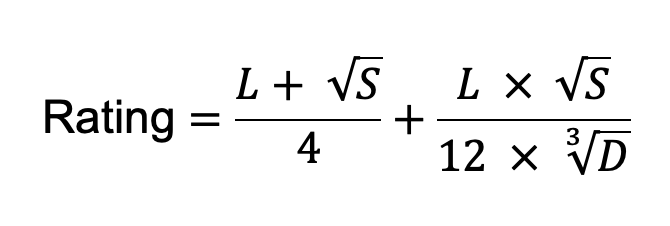 where:
where:
L =load waterline length modified by the “quarter beam length” measured at 1⁄4 of the beam at the load waterline
S = sail area
D = displacement in cubic inches (weight in pounds multiplied by 27 for saltwater)
There are also some explicit limitations on displacement, draft, freeboard, projections or hollows in the hull, and sail plan height, with rating penalties for exceeding the limits.
This rule included displacement explicitly. In the previous rules, displacement was controlled only indirectly, by the practical limitations imposed by length, beam, sail area, and stability. I suspect that this inclusion of displacement in the denominator of the rating equation encouraged somewhat heavier boats than, say, the 10-Rater rule. In fact, A-Class models do tend to be rather heavy. This increase in displacement shows clearly in the deeper underbody of the A-Class design, as revealed by comparing the lines drawings of Figs. 1 and 3.
Some measurement difficulties—mostly related to the use and determination of the quarter beam measurements—are likely. The modern A-Class in the UK has a detailed measurement procedure specification, which I understand can take a few hours to complete. I suspect that the difficulties of designing and measuring new boats designed to this rule explain why US VMYG activity in the A-Class is confined to already-existing, older models, which have presumably been “certified” sometime in their past.
By all accounts, A-Class rating rules produce boats that sail well and look good. At winds appropriate to their 1/6 scale size, they produce wave trains and heel angles that correspond to those of full-size yachts.
American Universal Rating Rule
Various other rating rules were developed in Europe and America. The “American Universal Rule” came to our attention when we were investigating the provenance of a design in our archives done by Thomas Darling in 1926. See Fig. 4.
The notes on the drawing sheet tabulate some weights and also give an equation calculating a rating of 20 (in units of inches, presumably). (Note: This does not indicate that the boat was a “20-Rater” as defined in the discussion of the “10-Rater” rule above. Rather, it means that the boat rated 20 according to the rating formula on the plans.)
The rating formula that matches the one on Darling’s plans is the American Universal Rule, which is: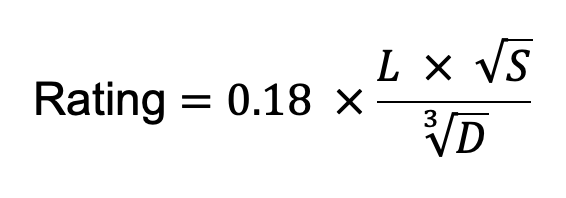 where:
where:
L = load waterline length, modified by a specified portion of the quarter beam length
S = sail area
D = displacement in cubic inches
and the overall rating is in units of length.
Savvy observers will note that Darling’s hull looks remarkably like that of a J-Class yacht. In fact, full-size J-boats were indeed designed to the American Universal Rule. J-Class yachts had a rating between 65 and 76 ft. Note that this is not the length of the boats, which all seemed to have waterline lengths in a small range around 83 ft, with rather large overhangs.
This short article cannot cover the details of the various rules, but, even without these details, I think we come away with an appreciation for model yacht designers in the first part of the 20th century (our “vintage” years). These were not casual builders. They understood boat performance attributes, and their designs reflected serious thought about the shape trade-offs demanded by the rating rules. It would appear that their model design efforts were similar to those required for full-size boats (although with simplified construction requirements). Based on historical accounts, they were also prolific designers/builders. Restoring, reproducing, and appreciating this heritage is part of our purpose.

